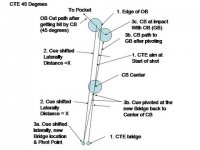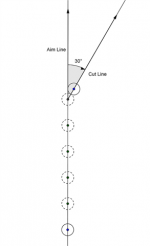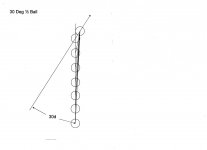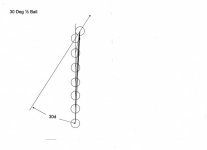What is the difference between these two ways?
You are using an out of date browser. It may not display this or other websites correctly.
You should upgrade or use an alternative browser.
You should upgrade or use an alternative browser.
Half Ball and CTE..Whats Different?
- Thread starter strokerace
- Start date
What is the difference between these two ways?
Some of your hit with CTE are not 1/2 HITS.
What is the difference between these two ways?[/QUOT Using CTE you do not shoot the center of the cb at the edge of the ball,it is just an initial reference,you have to offset and pivot back to center of the cb,there are a lot of past threads full of info about this.
Good luck Peteypooldude
1/2 ball:
Center of CB to edge (3:00 or 9:00) of OB gives one cut angle (~30 degrees) at at all distances that are not "too close" to the CB; with all normal bridge locations.
This is similar to the straight in shot - center of CB to center of OB, but at all distances.
Center of CB to edge (3:00 or 9:00) of OB gives one cut angle (~30 degrees) at at all distances that are not "too close" to the CB; with all normal bridge locations.
This is similar to the straight in shot - center of CB to center of OB, but at all distances.
1/2 ball:
Center of CB to edge (3:00 or 9:00) of OB gives one cut angle (~30 degrees) at at all distances that are not "too close" to the CB; with all normal bridge locations.
This is similar to the straight in shot - center of CB to center of OB, but at all distances.
Aiming the center of the CB at the edge of the OB gives a 30 degree cut (ignoring friction) relative to the aim line at all distances. The CB-OB distance doesn't matter - it's even true if the CB and OB are frozen.
If you think CB-OB distance does matter, then you're probably making the mistake of measuring the cut relative to the line through the CB and OB centers rather than the CB's initial direction along the aim line. That's an incorrect approximation of the cut angle at any distance, but does get progressively worse as the CB gets closer to the OB.
Robert
What is the difference between these two ways?
One has a pivot, the other has a pirouette. Where were you this past week?
Aiming the center of the CB at the edge of the OB gives a 30 degree cut (ignoring friction) relative to the aim line at all distances. The CB-OB distance doesn't matter - it's even true if the CB and OB are frozen.
If you think CB-OB distance does matter, then you're probably making the mistake of measuring the cut relative to the line through the CB and OB centers rather than the CB's initial direction along the aim line. That's an incorrect approximation of the cut angle at any distance, but does get progressively worse as the CB gets closer to the OB.
Robert
Thanks for the insight.
I understand what you are saying and I agree.
What is interesting, to me, is that when the OB and CB are frozen/kissing, there is no cut angle for at that point, the CB is aligned with the OB on the path to the pocket. So the relative cut angle approaches "0" the closer the CB gets to the OB.
Interesting, to me, obvious to others.
Last edited:
LAMas, I think Robert's point was that according to the standard definition of cut angle, which is the angle between the OB's post-impact direction and the CB's pre-impact direction, there still is a cut angle anywhere from 0 to 90 degrees, and even as the separation is reduced to near zero. A special case occurs when they're actually frozen, but there still is a cut angle, of sorts. Bob Jewett's 2X fuller system applies as far as the cueball's post-impact direction is concerned.Thanks for the insight.
I understand what you are saying and I agree.
What is interesting, to me, is that when the OB and CB are frozen/kissing, there is no cut angle for at that point, the CB is aligned with the OB on the path to the pocket. So the relative cut angle approaches "0" the closer the CB gets to the OB.
Interesting, to me, obvious to others.
The "impact angle" (Dr. Dave's term, a good one), on the other hand, is the OB's post-impact direction measured with respect to the pre-impact line of centers between the balls. This conforms to your description--it's zero whenever the balls are frozen.
Jim
What is interesting, to me, is that when the OB and CB are frozen/kissing, there is no cut angle for at that point, the CB is aligned with the OB on the path to the pocket. So the relative cut angle approaches "0" the closer the CB gets to the OB.
I have to disagree about there being no cut angle when they are frozen. By using your reasoning, NO shot would ever have a cut angle! That's because every shot involves the CB getting progressively closer to the OB until it results in the moment when the CB and OB are frozen. What's different in your model between that moment and just starting out frozen to begin with?
It might be easier to understand frozen ball cut angles by thinking about how energy splits between CB and OB. You put energy into the system with your cue in a certain direction, and it gets split between the CB and OB in a certain proportion. Although the OB goes in the roughly the same direction for different initial stroking directions, the relative speeds between CB and OB will be different. Accounting for throw and Hertz's law in the collision to satisfy physics geeks doesn't change the fact that the relative velocities between CB and OB are different for each initial aiming direction.
Energy is directed along the initial aim line, and the fraction of that energy transferred to the OB is based on the cut angle. Does that make sense?
Robert
Can you diagram what you mean to say?
Here's a picture showing several CB locations along the same aiming line just to make sure we're all talking about the same thing. Energy is directed along the aim line even when they are frozen.
Robert
Attachments
Last edited:
I normally adress the OB from behind the CB looking for the contact/impact point on the OB.
So I place my cue pointing the tip through center of the OB and on a line to the center of the pocket.
If I draw a line from the center of the OB to the center of the CB, at a large distance, the cut angle
looks to be 30 degrees for a 1/2 OB (left edge) cut to a pocket to the right - like your drawing.
What was being discussed is that as the CB gets closer to the OB, the perceived angle decreases from
30 degrees to 0 degrees - when viewed behind the CB looking at the center of the OB.
When the OB and CB are kissing, I can jack up and try to draw the CB while aiming through to the pocket
at 0 degrees.
I can also throw the OB by shooting through the left edge of the OB (1/2 Ball) as well.
Thanks.
So I place my cue pointing the tip through center of the OB and on a line to the center of the pocket.
If I draw a line from the center of the OB to the center of the CB, at a large distance, the cut angle
looks to be 30 degrees for a 1/2 OB (left edge) cut to a pocket to the right - like your drawing.
What was being discussed is that as the CB gets closer to the OB, the perceived angle decreases from
30 degrees to 0 degrees - when viewed behind the CB looking at the center of the OB.
When the OB and CB are kissing, I can jack up and try to draw the CB while aiming through to the pocket
at 0 degrees.
I can also throw the OB by shooting through the left edge of the OB (1/2 Ball) as well.
Thanks.
Attachments
Last edited:
I understand that assuming the angle of the cut from the center of the
OB to the center of the CB is incorrect, but it is where I start.
I then adjust looking at the aim line - CB to the ghost ball for the final aim.
That, in this example is the left edge of the OB.
So the 1/2 ball shot works for "all" distances between the OB and the CB.
Thanks
Sorry for the large .jpg...I don't know how to reduce the scanned image.
Help please.
OB to the center of the CB is incorrect, but it is where I start.
I then adjust looking at the aim line - CB to the ghost ball for the final aim.
That, in this example is the left edge of the OB.
So the 1/2 ball shot works for "all" distances between the OB and the CB.
Thanks
Sorry for the large .jpg...I don't know how to reduce the scanned image.
Help please.
I understand that assuming the angle of the cut from the center of the OB to the center of the CB is incorrect, but it is where I start.
That's what I suspected, and our diagrams help make the distinction clear. Something about 1000 words and all that...
To get a more quantitative feel for the 1/2-ball cut angle error between measuring from a line through the OB center vs the edge, here's a rule of thumb:
There's about a 5 degree spread between aiming at the OB center vs its edge when the CB-OB distance is 1 diamond. Every time you double CB-OB distance, you cut the spread in half. Every time you halve the CB-OB distance, you double the spread (it's conveniently linear until you're almost frozen).
So, a 2-diamond separation gives ~2-1/2 degree error and a 4-diamond separation is ~1-1/4 degree error, which agrees with you're saying it's a good approximation for large distances.
On the other hand, 1/2-diamond separation gives ~10 degrees error, and 1/4-diamond separation is ~20 degrees error. Obviously, there's a 30 degree error when they're finally frozen! That's why it gets a lot worse as you get closer.
Incidentally, this can also be used to estimate max margin of error in degrees due to pocket size. A 4-1/2" pocket is two balls wide, so that's roughly + or - 1/2-ball to either side of center pocket. Therefore, you just double the error as figured above. 1-diamond from the pocket is +/-5 or ~10 degrees allowable error, 2-diamonds away is ~5 degrees, etc. Of course, the pocket becomes effectively smaller as you shoot down the rail and/or increase speed.
Sorry for the large .jpg...I don't know how to reduce the scanned image.
Help please.
There are various tools you can use depending on your OS (I use the old Image Resizer Power Toy on my XP email machine, for example).
There are also sites like www.ShrinkPictures.com that resize images for free. Just upload your picture and choose the settings. I've attached your image resized via that site using "best" jpg compression and 600 pixels as the largest dimension. If you cropped the empty right side, the part with the drawing could be effectively bigger with the same largest dimension.
Robert
Attachments
Thanks,
This is better. I tried a .ppt to .jpg converter and resized it in Picasa.
I will play around with your suggestions about diamonds, distance and angles - new to me.
For now, I have been adjusting my stance over the cue to sight at the ghost ball for a more
accurate cut angle perception rather than center of CB to center of OB.
Thanks all.
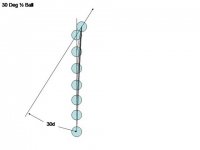
This is better. I tried a .ppt to .jpg converter and resized it in Picasa.
I will play around with your suggestions about diamonds, distance and angles - new to me.
For now, I have been adjusting my stance over the cue to sight at the ghost ball for a more
accurate cut angle perception rather than center of CB to center of OB.
Thanks all.

Last edited:
What is the difference between these two ways?
The 1/2 ball shot/cut for CTE is said to not require a shift and pivot.
This is also true for the straight in shot in CTE.
For other cut angles, there is a parallel shift that varies by 1 cue tip to 1/2 ball.
This moves the bridge to a new location from which one pivots the tip of the cue
back to the center of the CB from where the CB/shot is sent to the OB.
This is a drawing of a ~45 degree cut. For more detail read the CTE threads.
